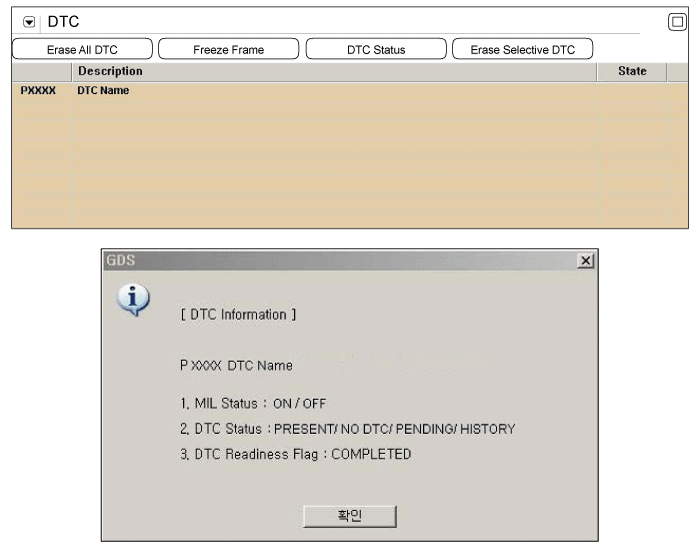
The Electronic Throttle
Control(ETC) system is made of the components throttle body, Throttle
Position Sensor(TPS) 1&2 and Accelerator Position Sensor(APS) 1&2.
The APS is mounted in the accelerator pedal to detect the opening angle of
the accelerator pedal. It has 2 sensors to detect the accelerator position
and a malfunction of the accelerator position sensor. The PCM judges the
current opening angle of the accelerator pedal from APS1&2, and the
PCM controls the throttle motor based on these signals.
Checking output signals
from APS 2, under detecting condition, if output signals are detected
below the threshold, PCM sets P2127. MIL(Malfunction Indication Lamp)
turns on.
Item
|
Detecting
Condition
|
Possible Cause
|
DTC
Strategy
|
| •
|
This code detects a continuous short to
ground or open in either the circuit or the
sensor | |
| •
|
Open or short to ground in Power
circuit. |
| •
|
Open or short to ground in signal
circuit. |
|
EnableConditions
|
|
Threshold
|
|
Diagnosis
Time
|
|
MIL On
Condition
|
|
Pedal Position
|
Output Voltage(V) [Vref =
5.0V]
|
APS1
|
APS2
|
C.T
|
0.7 ~
0.8V
|
0.275 ~
0.475V
|
W.O.T
|
3.8 ~
4.4V
|
1.75 ~
2.35V
|


Fig.1) This is a signal
waveform of APS 1 & 2 which shows that APS 2 increases voltage just
half of APS 1 voltage increase when accelerating.
| 1. |
Check DTC Status
| (1) |
Connect scantool to Data Link
Connector(DLC). |
| (3) |
Select "DTC" button, and then Press "DTC
Status" to check DTC's information from the DTCs
menu. |
| (4) |
Read "DTC Status"
parameter.

|
| (5) |
Is parameter displayed "Present
fault"?
|

|
▶ Go
to "Terminal and connector inspection"
procedure.
|
|

|
▶
Fault is intermittent caused by poor contact in the
sensor's and/or PCM's connector or was repaired and PCM
memory was not cleared. Thoroughly check connectors for
looseness, poor connection, ending, corrosion,
contamination, deterioration, or damage. Repair or
replace as necessary and go to "Verification of Vehicle
Repair"
procedure.
|
| |
| Terminal And Connector
Inspection |
| 1. |
Many malfunctions in the electrical system are
caused by poor harness and terminal condition. Faults can also be
caused by interference from other electrical systems, and mechanical
or chemical damage. |
| 2. |
Thoroughly check connectors for looseness,
poor connection, bending, corrosion, contamination, deterioration,
or damage. |
| 3. |
Has a problem been found?
|

|
▶ Repair as
necessary and go to "Verification of Vehicle Repair"
procedure
|
|

|
▶ Go to
"Power Circuit Inspection "
procedure.
|
|
■ Check voltage
| 1. |
IG "OFF" and disconnect APS
connector. |
| 3. |
Measure voltage between APS2 power terminal of
APS harness connector and chassis ground.
Specification
: Approx. 5V
| |
| 4. |
Is the measured voltage within specification
?
|

|
▶ Go to
"Signal Circuit Inspection" procedure.
|
|

|
▶ Repair or
replace as necessary and then, go to "Verification of Vehicle
Repair"
procedure.
|
|
| Signal Circuit
Inspection |
■ Check short to ground in harness
| 1. |
IG "OFF" and disconnect APS connector and PCM
connector. |
| 2. |
Measure resistance between APS2 signal
terminal of APS harness connector and chassis ground.(Measurement
"A") |
| 3. |
Measure resistance between APS2 signal and
APS1(2) ground terminals of APS harness connector.(Measurement
"B")
|
| 4. |
Is the measured resistance within
specification ?
|

|
▶ Go to
"Check open in harness" as follows.
|
|

|
▶ Repair or
replace as necessary and then, go to "Verification of Vehicle
Repair"
procedure.
|
|
■ Check open in harness
| 1. |
IG "OFF" and disconnect APS connector and PCM
connector. |
| 2. |
Measure resistance between APS2 signal
terminal of APS harness connector and APS2 signal terminal of PCM
harness connector.
|
| 3. |
Is the measured resistance within
specification ?
|

|
▶ Go to
"Component Inspection" procedure.
|
|

|
▶ Repair or
replace as necessary and then, go to "Verification of Vehicle
Repair"
procedure.
|
|
| 1. |
Check APS
| (1) |
Ignition "ON" & ENG
"OFF". |
| (2) |
Measure waveform of APS by pressing and
depressing accelerator pedal with scantool.
Specification :
Pedal Position
|
Output Voltage(V) [Vref =
5.0V]
|
APS1
|
APS2
|
C.T
|
0.7 ~ 0.8V
|
0.275 ~ 0.475V
|
W.O.T
|
3.8 ~ 4.4V
|
1.75 ~
2.35V
|

|
| (3) |
Is the measured signal waveform O.K
?
|

|
▶
Substitute with a known-good PCM and check for proper
operation. If the problem is corrected,replace PCM and
then go to "Verification of Vehicle Repair"
procedure.
|
There is a memory reset
function on scantool that can erase optional parts
automaticallydetected and memorized by
PCM.
Before or after testing PCM
on the vehicle, use this function before reusing
the PCM | |
|

|
▶
Substitute with a known-good APS and check for proper
operation. If the problem is corrected,replace APS and
then go to "Verification of Vehicle Repair"
procedure.
|
| |
| Verification Of Vehicle
Repair |
After a repair, it is
essential to verify that the fault has been corrected.
| 1. |
Connect scantool and select "DTC"
button. |
| 2. |
Press "DTC Status" button and confirm that
"DTC Readiness Flag" indicates "Completed". If not, drive the
vehicle within conditions noted in the freeze frame data or enable
conditions |
| 3. |
Read "DTC Status"
parameter |
| 4. |
Is parameter displayed "History(Not Present)
fault"?
|

|
▶ System
performing to specification at this time. Clear the
DTC
|
|

|
▶ Go to the
applicable troubleshooting
procedure.
|
|